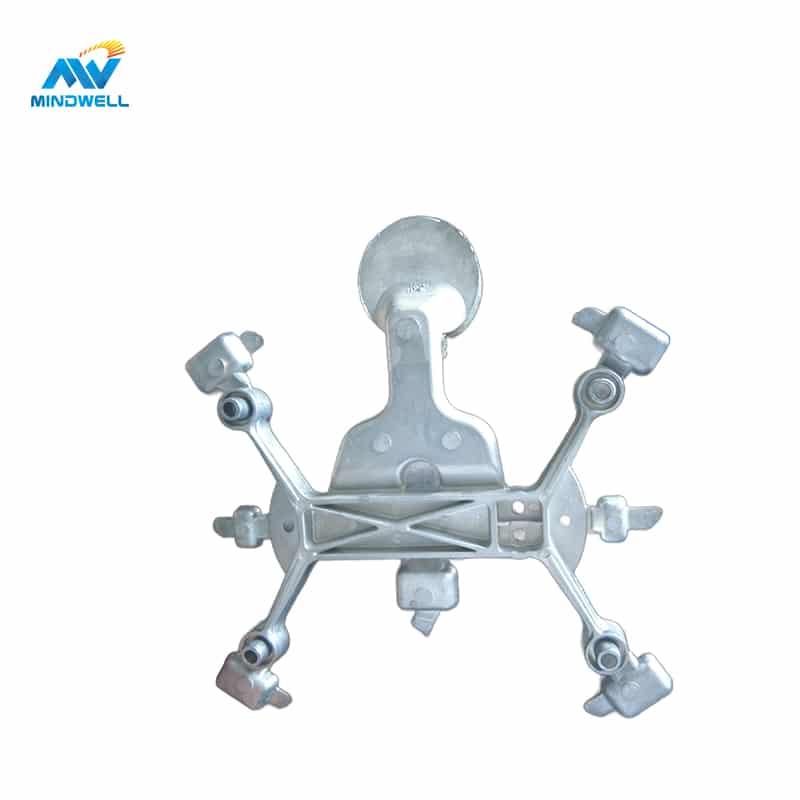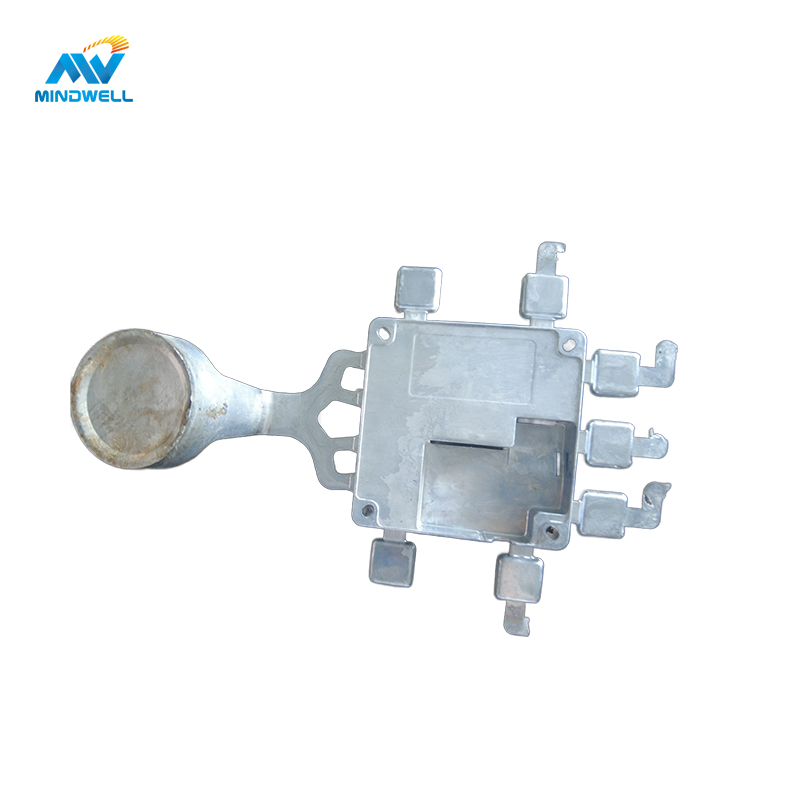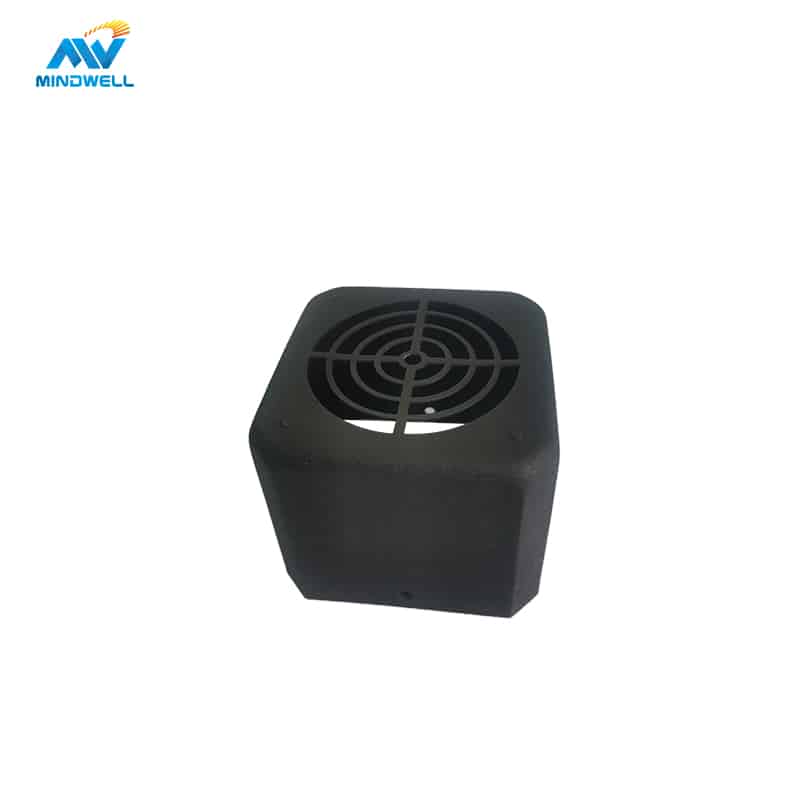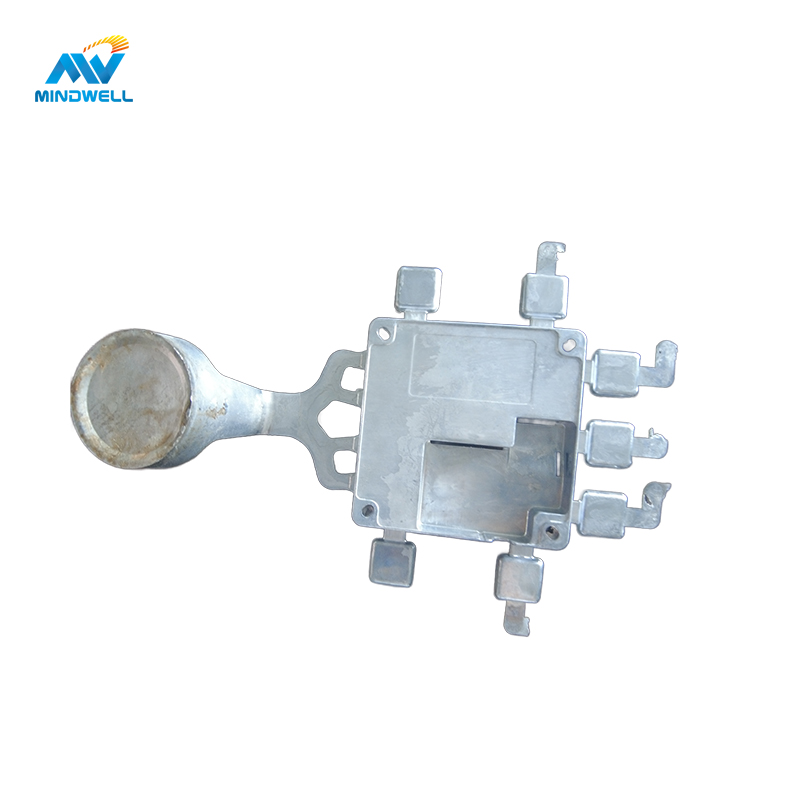Алюминиевые детали с ЧПУ - это алюминиевые детали, изготовленные с использованием технологии компьютерного числового программного управления (ЧПУ). Обработка с ЧПУ - это современный метод производства, основанный на технологии компьютерного числового управления, который позволяет изготавливать алюминиевые детали различных форм и размеров с высокой точностью и эффективностью.
Алюминиевые детали с ЧПУ находят широкое применение во многих областях, таких как аэрокосмическая промышленность, автомобилестроение, электроника, медицинское оборудование и т.д. Эти детали обычно требуют высокой точности, прочности и легкости, чтобы адаптироваться к различным сценариям применения. Технология обработки с ЧПУ может удовлетворить эти требования и позволяет обрабатывать алюминиевые материалы в различные сложные формы и структуры.
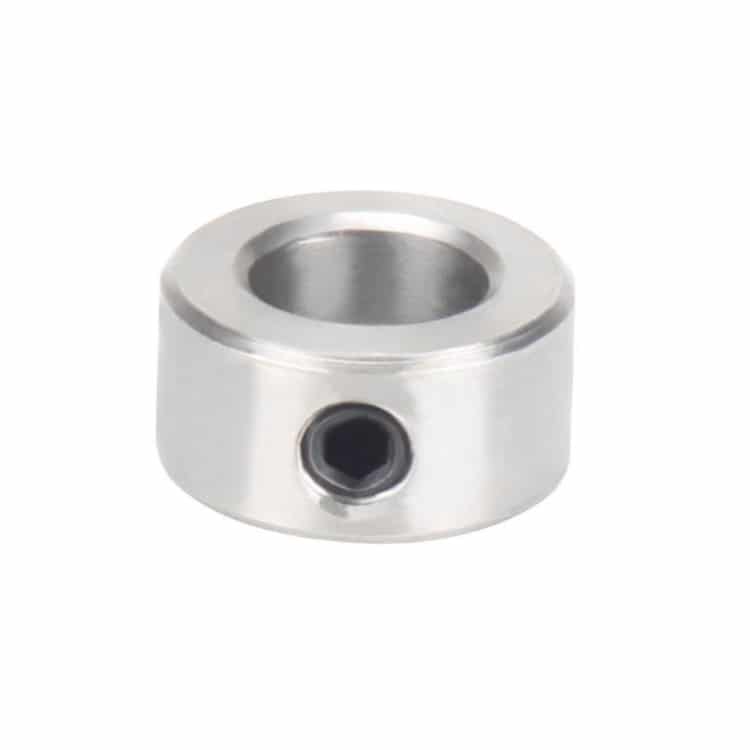
Процесс изготовления алюминиевых деталей с ЧПУ на заказ
Принципы обработки алюминия с ЧПУ
Обработка алюминия с ЧПУ - это технология, использующая компьютерную систему управления для выполнения обработки алюминиевых материалов с ЧПУ. Он пишет программы обработки, вводит параметры обработки в компьютер, а затем управляет станком через компьютерную систему управления, чтобы тот мог обрабатывать в соответствии с заданной траекторией, скоростью и глубиной обработки. Технология обработки алюминия с ЧПУ обладает такими характеристиками, как высокая точность, высокая эффективность, высокая стабильность и высокая гибкость.
Процесс изготовления алюминиевых деталей с ЧПУ на заказ
- Проектирование и моделирование: Для проектирования и моделирования деталей мы используем программное обеспечение Computer Aided Design (CAD). Дизайнеры могут проектировать форму, размер и структуру деталей в соответствии с потребностями и создавать цифровые модели.
- Подготовка материалов: Разрежьте требуемые алюминиевые материалы на части соответствующих размеров и форм, а также выполните необходимые обработка поверхностиЧистка, полировка и т.д.
- Обработка с ЧПУ: Импорт цифровых моделей для обработки на станках с ЧПУ центры для автоматизированной обработки. Обрабатывающий центр может выполнять точную резку, сверление, фрезерование и другие операции на основе модели для достижения высокоточной обработки.
- Инспекция и контроль качества: Проведите проверку качества обработанных алюминиевых деталей с ЧПУ, чтобы убедиться, что они соответствуют требованиям к конструкции и использованию.
- Сборка и использование: Соберите алюминиевые детали с ЧПУ в соответствующие изделия и проведите необходимые испытания и обслуживание.
В целом, алюминиевые детали с ЧПУ - это передовой метод производства, который позволяет изготавливать высокоточные, высокоэффективные и легкие детали. Алюминиевые детали с ЧПУ, которые мы производим, имеют широкий спектр применения во многих областях.
На что следует обратить особое внимание при обработке прецизионных деталей с ЧПУ?
При обработке прецизионных деталей с ЧПУ необходимо соблюдать некоторые меры предосторожности, требующие особого внимания:
Проектирование и подготовка чертежей:
Убедитесь, что проектные чертежи точны и содержат все необходимые размеры, допуски и требования к поверхности.
Рационально разрабатывать формы и конструкции деталей, учитывая ограничения и проблемы, которые могут возникнуть в процессе обработки.
выбор материала:
Выбирайте подходящие материалы в зависимости от назначения и требований к детали. Различные материалы имеют разные механические свойства и характеристики обработки, которые необходимо выбирать в зависимости от реальной ситуации.
Выбор инструмента и параметры резания:
Выберите подходящие типы инструментов, их размеры и параметры резания в зависимости от типа материала, формы детали и требований к обработке.
Обращайте внимание на настройки таких параметров, как скорость резания, подача и глубина резания, чтобы обеспечить качество обработки и срок службы инструмента.
Зажим и позиционирование:
Выберите подходящее приспособление и метод позиционирования, чтобы обеспечить стабильность и точность деталей во время обработки.
Избегайте чрезмерного или неравномерного усилия зажима, которое может привести к деформации или нарушить точность обработки.
Последовательность обработки и планирование процесса:
Правильно спланируйте последовательность обработки, чтобы избежать увеличения сложности последующей обработки из-за остаточного напряжения или деформации во время обработки.
В соответствии с характеристиками и требованиями к деталям, выберите подходящую технологию обработки, например, фрезерование, сверление, обработка резьбы и т.д.
Мониторинг обработки и контроль качества:
В процессе обработки осуществляется своевременный мониторинг состояния обработки и контроль условий резания и качества поверхности.
Проводить необходимые измерения размеров и проверку поверхности, чтобы гарантировать, что точность и качество обработки соответствуют требованиям.
Управление и обслуживание инструментов:
Регулярно проверяйте и заменяйте режущие инструменты для поддержания качества обработки и срока службы инструмента.
Уделяйте внимание чистке, смазке и хранению ножей, чтобы предотвратить их повреждение или появление ржавчины.
Меры предосторожности:
Соблюдайте правила безопасной работы и используйте средства индивидуальной защиты для обеспечения безопасности операторов.
Убедитесь, что станки и оборудование находятся в нормальном рабочем состоянии, и регулярно проводите техническое обслуживание и осмотры.
Какие три элемента должны быть включены в программу обработки алюминиевых деталей с ЧПУ?
Три элемента программы обработки алюминиевых деталей с ЧПУ включают в себя: дизайн, технологию обработки и контроль качества.
Во-первых, дизайн - это основа программы обработки алюминиевых деталей с ЧПУ. Факторы проектирования включают форму, размер, материал и т. д. деталей. В процессе проектирования необходимо учитывать функциональные требования, требования к сборке и взаимодействие с другими частями деталей. Конструктор также должен использовать программное обеспечение CAD для создания чертежей, чтобы обеспечить точность и осуществимость конструкции.
Во-вторых, процесс обработки является ядром программы обработки алюминиевых деталей с ЧПУ. Процесс обработки включает в себя выбор соответствующих станков, режущих инструментов и параметров резки. В процессе обработки необходимо выбрать подходящий метод обработки в зависимости от формы и свойств материала детали, например, точение, фрезерование, сверление и т.д. В то же время необходимо определить параметры обработки, такие как скорость резания, скорость подачи и глубина резания, чтобы обеспечить точность и качество поверхности деталей.
Наконец, контроль качества является важной частью процедуры обработки алюминиевых деталей с ЧПУ. Контроль качества включает в себя проверку сырья, контроль процесса обработки и проверку готовой продукции. В процессе обработки требуется регулярное обслуживание и поддержание в рабочем состоянии технологического оборудования для обеспечения его нормальной работы. В то же время необходимо использовать измерительные инструменты для контроля размеров и качества поверхности деталей, чтобы убедиться, что детали соответствуют проектным требованиям. В случае обнаружения проблем необходимо своевременно скорректировать технологию обработки, чтобы повысить качество продукции.
Подводя итог, можно сказать, что три элемента программы обработки алюминиевых деталей с ЧПУ включают в себя дизайн, технологию обработки и контроль качества. Эти элементы взаимосвязаны и являются неотъемлемыми. Только на основе успешной работы в этих трех аспектах можно достичь высокого качества обработки алюминиевых деталей с ЧПУ.
Параметры резания при обработке алюминиевых материалов с ЧПУ
Параметры резания при обработке алюминия на станках с ЧПУ в основном включают скорость резания, скорость подачи и глубину резания. Выбор этих параметров напрямую влияет на качество и эффективность обработки, поэтому следует выбирать разумные настройки, исходя из конкретной ситуации. Скорость резки: Под скоростью резания понимается длина алюминиевого материала, разрезаемого режущим инструментом за единицу времени. Для алюминиевых материалов скорость резки обычно высокая, обычно в пределах 100-300 м/мин. Если скорость резки слишком низкая, сила резания увеличивается, а износ инструмента ускоряется. Если скорость резки слишком высока, шероховатость поверхности алюминиевого материала увеличится, и даже появятся заусенцы и другие проблемы.
- Feed speed: The feed speed refers to the distance the cutting tool moves to the aluminum material per unit time. Feed speed is generally low, usually between 0.05-0.5mm/r. If the feed rate is too low, the processing efficiency will be low, and if the feed rate is too high, the surface roughness of the aluminum material will increase.
- Depth of cut: Depth of cut refers to the distance between the cutting tool and the surface of the aluminum material during each cut. The depth of cut should be determined based on the hardness of the aluminum, the size and material of the tool, and other factors. Generally speaking, the cutting depth should not be too large, so as not to cause a decrease in processing accuracy or accelerated tool wear.
In short, the cutting parameters for CNC machining of aluminum need to be reasonably set according to specific conditions to ensure processing efficiency and processing quality. When setting cutting parameters, the characteristics and processing requirements of aluminum should be fully considered, and continuous adjustments and optimizations should be made to improve processing efficiency and quality.
The precision of CNC machined parts
The precision of CNC machined aluminum parts can reach a very high level, often to a few microns (μm) or even smaller. Here are some common precision requirements for CNC machined aluminum parts:
- Dimensional accuracy:CNC machining can achieve high dimensional accuracy, typically achieving tolerance requirements of ±0.01mm or less. This means that the dimensions of the machined part are very close to the dimensions on the design drawing.
- Surface roughness:CNC machining can control the surface roughness of parts to meet specific requirements. Surface roughness Ra 0.8μm or less can usually be achieved, and sometimes even Ra 0.4μm or less can be achieved.
- Parallelism and perpendicularity:CNC machining can ensure the parallelism and perpendicularity of parts and ensure that the relationship between the various surfaces of the parts meets the requirements. Parallelism and verticality requirements within 0.02mm can usually be achieved.
- Aperture accuracy:CNC machining can achieve high-precision aperture processing, including drilling, reaming, etc. It is usually possible to achieve H7 level aperture accuracy, that is, the aperture is very close to the size required by the design.
It should be noted that actual accuracy requirements depend on specific part design and processing requirements. Different materials, shapes and processing methods may affect accuracy. In addition, factors such as the performance of the machine tool, tool quality and processing environment also need to be considered.
Application of CNC machining technology in aluminum alloy parts processing
- Design and processing of parts
CNC processing technology can be programmed according to the design requirements of the parts to process aluminum alloy parts.
Various complex-shaped parts, such as curved surface parts, aperture parts, etc., can be processed through CNC processing equipment to meet the needs of different industries.
- Processing optimization
CNC machining technology can improve processing efficiency and quality through optimized processing.
By optimizing parameters such as cutting tools, cutting speed and feed speed, cutting time and cutting force can be reduced, and processing efficiency and surface quality of parts can be improved.
- Inspection and measurement of parts
CNC processing technology can detect and measure parts through the measuring device that comes with the processing equipment.
The size and shape of the parts can be monitored in real time through the measuring device, thereby ensuring the quality and accuracy of the parts.
- Repair and modification of parts
CNC processing technology can realize the repair and modification of aluminum alloy parts.
Damaged parts can be repaired through CNC processing equipment, or old parts can be transformed, thereby improving the service life and performance of the parts.
What are the precision machining surface treatment methods of CNC aluminum products?
After precision machining of CNC aluminum products, in order to improve their surface quality and corrosion resistance, surface treatment is required. Common surface treatment methods include anodizing, electrophoretic coating, sandblasting, polishing, etc.
- Anodizing: Anodizing is a common surface treatment method that can form a dense and uniform oxide film on the surface of aluminum products to improve the corrosion resistance and surface hardness of aluminum products. At the same time, anodizing can also change the color of aluminum products through dyeing and enhance their beauty.
- Electrophoretic coating: Electrophoretic coating is a method of attaching paint to the surface of aluminum products, which can form a uniform and dense coating to improve the corrosion resistance and surface quality of aluminum products. Different coatings can be used for electrophoretic coating, such as polyester, epoxy, acrylic, etc.
- Sandblasting: Sandblasting is a method of mechanical surface processing. It can polish the surface of aluminum products by spraying abrasives at a high speed to remove surface burrs and stains, thereby improving its surface finish and aesthetics.
- Polishing: Polishing is a method of grinding and polishing the surface of aluminum products to remove surface burrs and stains and improve its surface finish and brightness. At the same time, polishing can also change the surface morphology and texture of aluminum products and enhance their aesthetics.
In short, surface treatment is required after precision machining of CNC aluminum products to improve their surface quality and corrosion resistance. Common surface treatment methods include anodization, electrophoretic coating, sand blasting, polishing, etc.
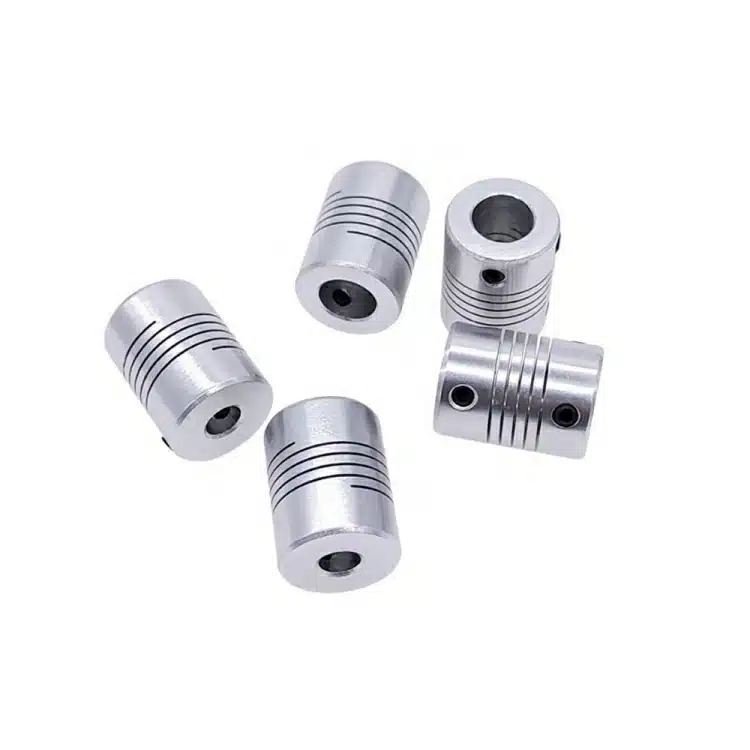
The advantages and disadvantages of CNC aluminum parts processing
CNC machining is a method in which machine tools are controlled by a computer program for processing. It has many advantages and some disadvantages. Here’s a detailed explanation of the pros and cons of CNC machining:
Преимущества:
The advantages of CNC aluminum parts mainly lie in high precision, high efficiency, flexibility, reduced labor intensity, stable product quality and customizable services, making CNC processing technology have broad application prospects in the field of aluminum parts manufacturing.
- High precision: CNC machining can achieve very high machining accuracy, usually within a few microns. This makes CNC machining very suitable for industries that require high-precision parts, such as aerospace, medical equipment, etc.
- High Repeatability: Since CNC machining is controlled by a computer program, it ensures that every part is the same size and shape. This is very important for mass production, increasing production efficiency and reducing human errors.
- Versatility: CNC machine tools can perform a variety of different types of machining operations, such as milling, turning, drilling, cutting, etc. This makes CNC machining extremely flexible to meet the needs of different industries and applications.
- High degree of automation: During the CNC machining process, the operator only needs to write programs and monitor the operation of the machine tool without directly participating in the machining process. This reduces labor costs and enables continuous processing without human intervention.
- High machining efficiency: CNC machine tools can process at higher speeds and feed rates, thereby improving production efficiency. In addition, due to the high degree of automation, human errors and downtime can be reduced, further increasing processing efficiency.
shortcoming:
- High Cost: CNC machine tools are costly to purchase and maintain. Additionally, operators need to be trained to write programs and operate machine tools, which also increases training costs.
- High requirements for operators: CNC machining requires operators to have certain programming and machine tool operating skills. For operators without relevant experience, learning and mastering these skills may take some time and effort.
- Requires professional maintenance: CNC machine tools require regular maintenance and upkeep to ensure their normal operation and accuracy. This requires professional technicians to maintain, increasing maintenance costs and workload.
To sum up, CNC processing has the advantages of high precision, high repeatability, versatility, high degree of automation and high processing efficiency. However, it also suffers from the disadvantages of high cost, high operator requirements and size, and the need for professional maintenance. In practical applications, the suitability of CNC machining needs to be evaluated according to specific needs and conditions.
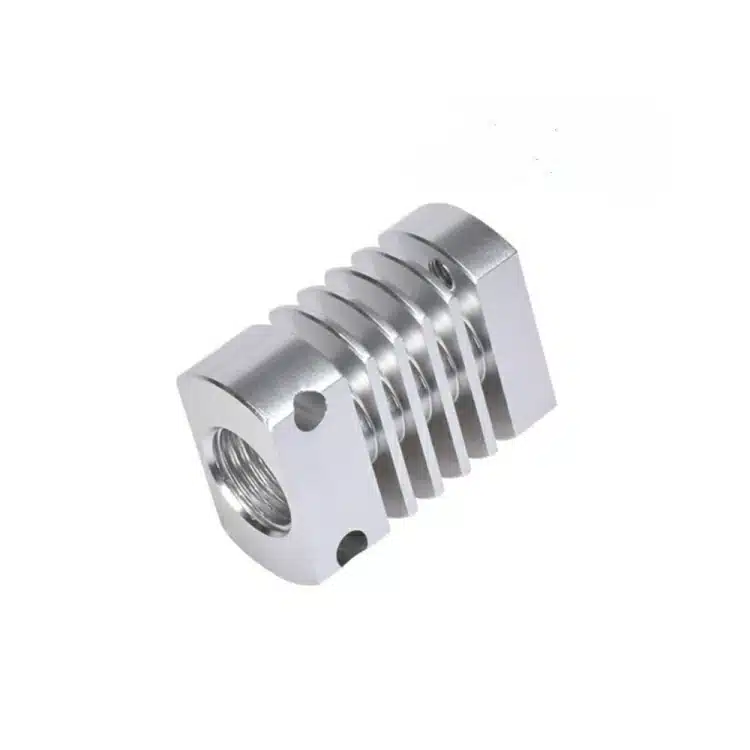
Application fields of aluminum CNC processing
- Automobile manufacturing industry: Aluminum CNC processing technology has been widely used in the automobile manufacturing industry.
For example, the processing of parts such as automobile bodies and engines requires high-precision and high-quality processing, and aluminum CNC processing technology can meet these needs.
- Aerospace industry: CNC processing technology for aluminum materials also has important applications in the aerospace industry.
The aerospace industry has very high requirements for precision and quality of parts, and aluminum CNC processing technology can achieve high-precision, high-quality processing, so it is widely used in aerospace manufacturing.
- Electronic product manufacturing industry: The electronic product manufacturing industry has high requirements for the accuracy and size of parts, and aluminum CNC processing technology can meet these requirements.
For example, the casing components of electronic products such as mobile phones and tablet computers usually require high-precision processing, and aluminum CNC processing technology can achieve this requirement. The application fields of CNC aluminum parts are very wide, mainly depending on the accuracy and quality requirements of the parts. With the continuous development of science and technology, the accuracy and efficiency of CNC processing technology will be further improved, and the application fields of CNC aluminum parts will be more extensive in the future.
FAQs about CNC aluminum parts
What aluminum is used for CNC?
CNC machining is a traditional manufacturing process that uses drills and turning tools to create parts by removing material from solid blocks of material. This process is fast, highly repeatable, and ideal for creating parts with tight tolerances. CNC machining can be done with any sufficiently rigid material—from plastic to metal to fiberglass—with aluminum being a popular choice for product teams.
Broadly speaking, aluminum is a strong, non-magnetic, cost-effective material that is highly resistant to corrosion. Here’s everything engineers and designers should know about the most common aluminum types used for CNC machining, and how to choose the type that’s best for their next project.
1.Aluminum 6061-T6
6061-T6 is one of the most popular aluminum alloys on the market and is used by most manufacturing companies as a standard grade for CNC machining. It is versatile and easy to process, and 6061 can even be heat treated differently.
6061-T6 is an excellent general-purpose material suitable for a variety of use cases. Although this material has a good strength-to-weight ratio, it is not suitable for high-stress applications. Common applications include automotive parts such as chassis, bicycle frames, valves, computer parts, and more.
Mechanical specifications:
Ultimate tensile strength: 310 MPa
Elongation at break: 17%
Modulus of elasticity: 68.9 GPa
Hardness: 60 HRB
2.Aluminum 7075-T6
For high stress or high performance applications, engineers should consider 7075-T6. This grade of aluminum is known for its excellent strength-to-weight ratio and its hardness can rival even some softer steels.
It is widely used in high stress applications in the aerospace and military industries. Common applications include aircraft parts, missile parts and fuse parts. Some performance bicycle and sporting goods products also include parts made from aluminum 7075-T6.
Although 7075-T6 has high strength and excellent mechanical properties, it also has its disadvantages. This material is less ductile and less corrosion-resistant than other grades. What’s more, aluminum 7075-T6 may be too expensive for some product teams.
Mechanical specifications:
Ultimate tensile strength: 434 – 580 MPa
Elongation at break: 10-15%
Modulus of elasticity: 69 – 76 GPa
Hardness: 79-86 HRB
Maximum operating temperature: 100°C
Aluminum 2024-T4
Aluminum 2024-T4 is a medium to high strength alloy with good fatigue resistance and fracture toughness. Aluminum 2024-T4 is not as strong as 7075-T6 but is still suitable for aerospace applications.
Common applications for aluminum 2024-T4 include aircraft fuselages, transport vehicle components and wing tension members. However, product teams should be aware that this grade of aluminum has poor corrosion resistance and is highly sensitive to thermal shock.
Mechanical specifications:
Ultimate tensile strength: 200 – 540 MPa
Elongation at break: 14 – 20%
Modulus of elasticity: 71 – 73.1 GPa
Hardness: 70 – 120 HB
Maximum operating temperature: 200 °C
4.Aluminum MIC 6
Aluminum MIC 6 is unique because its specific combination of alloy and casting method was developed to produce stable, high-tolerance plates. MIC 6 offers impressive stress relief performance, outstanding precision and high machinability. Aluminum MIC 6 is also stain-free and non-porous. This sleek, lightweight option can be found in machined parts, electronics, and even laser technology.
One drawback is that MIC 6 threads are not as strong as threads made from 6061, and particularly thin threads can cause early thread failure. Product designers should keep this limitation in mind during the material selection phase.
Mechanical specifications:
Ultimate tensile strength: 166 MPa
Elongation at break: 3%
Modulus of elasticity: 71 GPa
Hardness: 65 HB
Maximum operating temperature: 427°C
5.Aluminum 6082
Aluminum 6082 has similar properties to Aluminum 6061; however, 6082 has slightly higher tensile strength. Additionally, this type of aluminum has the highest strength of all 6000 series alloys and is very resistant to corrosion. The 6082 is a good choice for engineers who want more strength than the 6061 offers but don’t want to invest in the 7000 series.
Aluminum 6082 is ideal for general-purpose applications where increased strength and toughness are required. This material is popular in the construction industry and can be found in many bridges, towers and trusses. However, product designers should keep in mind that thin walls are difficult to produce with aluminum 6082.
Mechanical specifications:
Ultimate tensile strength: 140 – 340 MPa
Elongation at break: 6.3 – 18%
Modulus of elasticity: 69 – 71 GPa
Hardness: 35-56 HRB
Maximum operating temperature: 130 – 150 °C
Choose the right material for the job
If product teams choose to machine parts from aluminum, they can be confident that they are choosing a material that is strong, conductive, and resistant to corrosion. Aluminum alloys 2024-T4, 7075-T6 and 6082 are best suited for high performance applications, while 6061 and MIC 6 can be used in most situations where general purpose aluminum is sufficient.
Because CNC machining is so versatile, it can be difficult for engineers to narrow down the list of materials that are suitable for a specific project. With decades of technical experience, MINDWELL’s team of expert designers and engineers can help make material selection easier for every product team. We are committed to helping every customer innovate and achieve their desired results throughout the manufacturing process – and through our expert consultancy services, teams can be assured that their material selection will meet all key requirements.
Can you CNC 6061 aluminum?
With the continuous development of automobiles, aerospace, electronics and other fields, the requirements for aluminum plates used in CNC processing are also getting higher and higher. As a common aluminum alloy material, 6061 aluminum plate has the characteristics of good processing performance, corrosion resistance, high toughness, and no deformation after processing, so it has been widely used in the field of CNC machining. In the future, with the continuous development of various industries, the demand for 6061 aluminum plates for CNC processing will continue to increase, and at the same time, the requirements for its performance and quality will continue to increase.
When performing CNC machining, you need to understand the product specifications of 6061 aluminum plate. Typically, the specifications of 6061 aluminum plates can range from 0.1mm to 350mm, and the specific specifications can be customized according to actual needs. In addition, it is also necessary to understand the thickness, length, width and other parameters of the aluminum plate in order to better perform CNC processing.
6061 aluminum plate has good processing properties and can be processed in various shapes and sizes. At the same time, it also has good corrosion resistance and high toughness, allowing it to maintain stable performance in various environments. In addition, the 6061 aluminum plate also has good characteristics of not deforming after processing, which can ensure the accuracy of processing precision. When carrying out CNC processing, using 6061 aluminum plates can greatly improve production efficiency and product quality.
6061 aluminum plate for CNC machining has the characteristics of good processing performance, corrosion resistance, high toughness and no deformation after processing, and can meet the needs of different fields. In the future, with the continuous development of various industries, the demand for 6061 aluminum plates for CNC processing will continue to increase, and at the same time, the requirements for its performance and quality will continue to increase. Therefore, it is necessary to continuously strengthen technological research and development and product upgrades to meet the market demand for high-quality aluminum alloy materials.
Why do we usually not choose CNC precision machining method for processing mobile phone casings?
The reasons why CNC precision processing is not usually chosen for processing mobile phone casings are as follows:
High cost: CNC precision machining equipment and technology are relatively complex and require high investment costs. For the mass production of mobile phone casings, the use of CNC precision machining methods may lead to excessive costs and uncompetitiveness.
Low processing efficiency: CNC precision processing is usually a point-by-point or line-by-line processing method. For large-area mobile phone casings, the processing efficiency is relatively low. Mobile phone casings usually need to be mass-produced in a short time, so higher processing efficiency is required.
Material waste: CNC precision machining usually requires the entire workpiece to be fixed on a fixture before processing, and then processed point by point or line by line through the tool. For large-area workpieces such as mobile phone casings, using CNC precision machining methods may lead to a lot of material waste.
Surface treatment limitations: CNC precision machining usually cannot meet the special requirements of the surface of the mobile phone casing, such as smoothness, texture, anti-fingerprint coating, etc. Traditional injection molding, die-casting and other processing methods can better meet these requirements.
Complexity limitations: CNC precision machining has better processing results for parts with complex shapes and structures. However, for workpieces with large areas and many curves such as mobile phone casings, there may be processing difficulties and limitations.
In summary, although CNC precision machining has advantages in some areas, in terms of mobile phone casing processing, it is usually not the first choice due to factors such as high cost, low processing efficiency, material waste, surface treatment limitations, and complexity limitations. Way. In contrast, traditional processing methods such as injection molding and die-casting are more suitable for the mass production of mobile phone casings.
Why should we choose the appropriate cutting fluid when CNC precision machining aluminum alloy?
When precision CNC machining of aluminum alloys, it is very important to select the appropriate cutting fluid. Here are several commonly used cutting fluid types:
Water-soluble cutting fluid: Water-soluble cutting fluid is a common type of cutting fluid that is made of water mixed with additives. It has good cooling and lubrication properties, which can effectively reduce the processing temperature, extend tool life, and improve surface quality. For precision CNC machining of aluminum alloys, it is better to choose a water-soluble cutting fluid that contains anti-corrosion and antioxidants.
High-Performance Cutting Fluids: High-performance cutting fluids are typically synthetic liquids that provide excellent cooling, lubrication, and rust-preventive properties. They are able to provide higher cutting speeds and longer tool life while maintaining lower processing temperatures. For high-speed, high-precision precision CNC machining of aluminum alloys, using high-performance cutting fluid can achieve better processing results.
Dry machining: Dry machining means that no cutting fluid is used during the machining process, but cooling and lubrication are carried out by air or other means. Dry machining can reduce the use and disposal costs of cutting fluid while avoiding the impact of cutting fluid on the environment. However, dry machining may cause problems such as excessive processing temperatures and accelerated tool wear for precision CNC machining of aluminum alloys, so evaluation and selection need to be made based on the specific situation.
When choosing a cutting fluid, in addition to considering its performance characteristics, you should also pay attention to factors such as compatibility with aluminum alloys, environmental friendliness, and operating safety. The best cutting fluid selection should be evaluated based on comprehensive factors such as specific machining requirements, equipment conditions, and material properties, and should follow relevant safe operating procedures and regulations.
The difference between CNC professional processing and precision mechanical parts processing
CNC professional machining and precision mechanical parts processing are two different concepts, and there are some differences in scope, requirements and technology. The following are the differences between CNC professional processing and precision machinery parts processing:
range:
CNC professional machining usually refers to the use of computer numerical control (CNC) technology for the processing of various materials, including metal, plastic, wood, etc. It can range from simple parts to complex structures.
Precision mechanical parts processing focuses more on the processing of high-precision and high-demand mechanical parts, which are usually used in precision instruments, aerospace, medical equipment and other fields.
Processing requirement:
CNC professional processing focuses on production efficiency and cost control, and pursues higher processing speed and lower cost. Although a certain degree of accuracy is also required, compared to precision mechanical parts processing, the requirements for surface quality and dimensional tolerances may be looser.
The processing of precision mechanical parts has higher requirements on dimensional accuracy, surface quality, shape complexity, etc. High accuracy and tolerance requirements are often required to meet specific functional and assembly requirements.
techinque level:
The technical threshold for professional CNC processing is relatively low. Operators mainly need to master basic skills such as CNC programming, machine tool operation and tool selection.
The processing of precision mechanical parts requires a higher technical level and experience, and operators need to have more in-depth knowledge and skills in machining, including precision measurement, process optimization and processing parameter adjustment.
Equipment required:
CNC professional processing is usually performed using CNC machine tools, which can adapt to the processing needs of different materials and shapes.
Precision mechanical parts processing may require more specialized equipment and tools, such as high-precision CNC milling machines, grinders, wire cutting machines, etc., to meet higher processing requirements.
To sum up, there are some differences in scope, requirements and technology between CNC professional machining and precision mechanical parts machining. CNC professional processing pays more attention to production efficiency and cost control, while precision mechanical parts processing pays more attention to high-precision and high-demand processing, which requires a higher technical level and professional equipment. Choosing the right machining method depends on specific machining needs, materials and requirements
What is the CNC cutting speed of aluminium?
CNC cutting speed of aluminum The speed can be determined based on the following points
1.The total length of the outer diameter of the workpiece
2.Smooth and clean required
3.Processing technology
4.Machine turning performance
The speed and knife need to be matched well
Fine car can cost 100-200
Rough turning can cost 200-600


